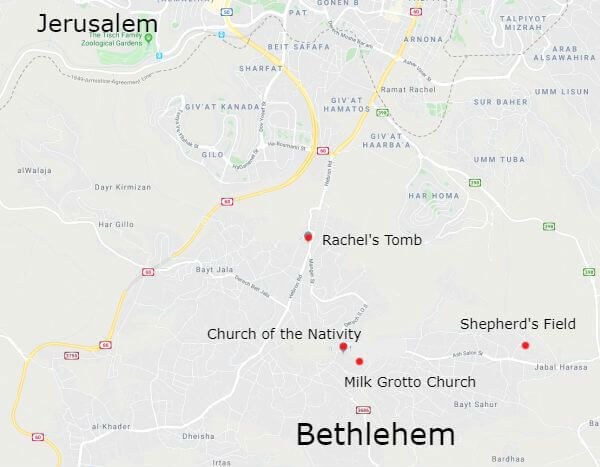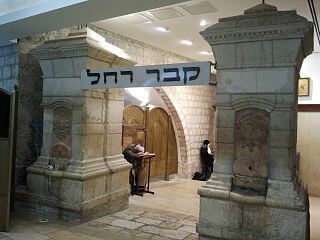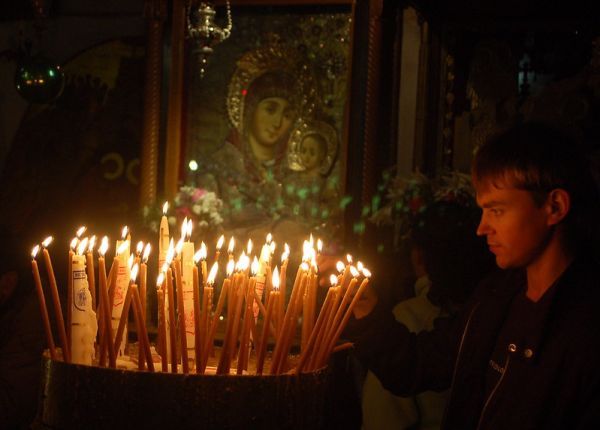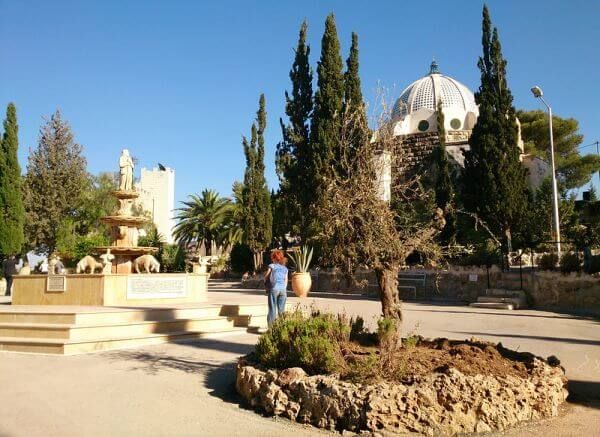What is so special about Bethlehem?
For Jews, the town’s holiness stems from its description as the burial place of Rachel, Jacob’s beloved wife (Genesis 35:19). Later on, the story of Ruth largely revolves around Bethlehem as the childhood home of King David and the place where he was anointed as king (Samuel I 16:1-13). Jewish tradition teaches that the Messiah will come from Bethlehem (Micha 5:2-5).
Christian tradition teaches that Bethlehem was the birthplace of Jesus (Matthew 2:1–12, Luke 2:4–20, and John 7:42). The Church of the Nativity was built by Constantine the Great in the 4th century CE over a cave believed to be the very spot where Jesus was born.
Join the fight for Israel’s fair coverage in the news
Bethlehem Now and Then
Sadly, this holy city has also become a city of contention.
The 1947 United Nations Partition Plan proposed placing Bethlehem, which is just six miles southwest of Jerusalem, under UN control as part of the Jerusalem international zone. During the War of Independence in 1948 which broke out after the Arab countries rejected the partition plan, the Arab Legion took control of Bethlehem. During these 19 years the Christian population declined from in the thousands.
Israel took control over the city in June 1967 during the Six Day War. The Christian residents asked Israel to annex the city and make it an official part of Israel but Israel rejected the idea, holding out for the possibility of it returning to Arab hands in the context of a peace agreement.

From 1967 until 1995 Bethlehem thrived. Christians came on pilgrimages to the Church of the Nativity in the millions and Jewish worshippers flocked to the revered Tomb of Rachel. Local vendors, restaurants, and hotels experienced great success as people from all faiths felt free to visit and walk the city streets.
But then in 1995, Israeli negotiations with the Palestinian leadership led to the Oslo II Accords in which Israel agreed to hand over civilian and security control to six cities – Jericho, Tulkarem, Nablus, Qalqilya, and Bethlehem.
Related reading: Jesus Was a Jew, Not a Palestinian
Bethlehem’s longtime Christian mayor, Elias Frej, begged Israeli Prime Minister Yitzchak Rabin not to give the city which has a majority Christian population over to the Palestinian Authority. He was afraid what Muslim rule would do to the Christians living there. But Israel, seeking a breakthrough in its relationship with the Palestinians, handed Bethlehem over to Palestinian rule on December 21, 1995.

This led to a period of horrific unrest in and around the holy city. Palestinian snipers began shooting at Jewish visitors to Rachel’s Tomb and even killed IDF soldiers who were protecting those worshippers. At times, the holy site which was fortified with concrete walls and roofs, had to be closed because of the threats from Palestinian terrorists. At other times visitors could only travel to the holy site in armored vehicles.
Aside from the attacks against Rachel’s Tomb, Bethlehem became a home base for terrorist cells and the launching pad for terror attacks against Israeli citizens. Its proximity to Jerusalem made the capital vulnerable. A few examples:
- Dec. 5, 2001: Palestinian terrorist Daoud Ali Ahmed Saad was sent by the Islamic Jihad base in Bethlehem to blow himself up in the heart of downtown Jerusalem. He did so, seriously injuring five civilians.
- Feb. 18, 2002: Palestinian terrorist Yasser Said Moussa Uda was sent by a Fatah/Tanzim terror group in Bethlehem to blow himself up next to a roadblock on a highway outside Jerusalem. He killed an Israeli police officer and seriously injured two civilians.
- March 2, 2002: Sent by a Fatah/Tanzim terror cell in the Bethlehem district, Muhammad Ahmed Abd El-Rahman Derameh was transported to Jerusalem where he blew himself up next to worshippers leaving a Jerusalem synagogue. He was driven there by Ashraf Hajajara who also lived in the Bethlehem district.
- March 17, 2002: Sent by an Islamic Jihad terror cell in Bethlehem, Akram Ishak Abdullah Nabatiti blew himself up at a major Jerusalem junction, seriously injuring 25 people.
- March 29, 2002: Palestinian terrorist Ayat Mohammed Latfi al-Akhras from the Bethlehem district blew herself up in a main Jerusalem supermarket, killing two civilians and injuring 22.
- March 31, 2002: Fatah operatives in Bethlehem prepared a bomb in a backpack and sent a 16-year-old boy to Jerusalem. The boy blew himself up next to a health clinic, injuring six civilians.
Related reading: The Second Intifada: Israeli Society Terrorized
Thus, Bethlehem became a base for Palestinian attacks against Israelis in Jerusalem. The mounting casualties forced the Israel Defense Forces to enter the city repeatedly to search and arrest the terrorists. Israeli forces also worked to dismantle the terrorist infrastructure in the city. Not only were numerous suicide bombings thwarted, security forces also uncovered mortars and infrastructure for the production of rockets.

Israel also had no choice but to construct the security barrier which envelops Bethlehem, giving it the feeling of a city under siege. These measures sharply reduced the number of successful terror attacks, but with a Hamas terror cell strongly entrenched in Bethlehem, attempts continue.
Christians and their holy sites suffered terribly from the fighting, especially the Church of the Nativity during a month-long siege. On April 2, during the IDF’s Operation Defensive Shield of 2002, Israeli forces moved to arrest a number of Palestinian fugitives in the city. Fifty fled to the church compound where they held 200 monks hostage. After 38 days, the siege ended peacefully with the Palestinian fugitives agreeing to go into exile, some to Gaza and others to Europe. Israeli security forces found 40 explosives left behind in the church compound, a number of which were booby trapped.
Related reading: A Guide to Israel’s UNESCO World Heritage Sites
Bethlehem’s Declining Christians
Aside from the challenges created by the security conflict, Christians see how radical Muslims persecute Christians throughout the Middle East and see that this has been happening since the Palestinian Authority was given control of the city. Examples of Palestinian Muslims intimidating their Christian neighbors include:
- Land theft either by force or by forged documents, with little to no recourse in the PA justice system.
- Muslim men harassing Christian women verbally or sexually.
- Christian businesses forced to pay protection money.
- Discrimination against Christians in job opportunities.
- Churches being broken into, looted or vandalized.
- Muslims who convert to Christianity face ostracism, assaults, even murder.
- Kidnapping and forced conversion of Christians.
All of this has led to a significant decline in the Christian population in Bethlehem.

Whereas Christians used to make up a majority of Bethlehem’s residents, today, after 25 years of Palestinian control over the city, Christians make up only 20% of its population. (A similar occurrence took place in Gaza where 5,000 Christians lived in 2005 when Israel pulled out. After 14 years of Hamas rule, only 1,000 Christians remain, and churches are often demolished.)
The situation in now Palestinian controlled Bethlehem stands in stark contrast to Israeli controlled Jerusalem, just six miles to the north. In Jerusalem the Christian population can practice their faith freely and securely. The Jerusalem municipality even provides free Christmas trees to Christian residents.
Related reading: Religious Freedom in Israel
In fact, Israel is the only country in the Middle East in which the native Christian population increased since 1948. By the end of 2019, Israel’s Christian population stood at 177,000, having grown 1.5 percent according to the Central Bureau of Statistics.
The lesson is clear. Christians thrive with total religious freedom in Israeli-controlled areas, and suffer when Israel yields control to radical Palestinian forces.
Featured image: Rachel’s Tomb via Wikimedia Commons; Church of the Nativity CC BY-SA Dan; Shepherd’s Field CC BY-NC fabcom;

